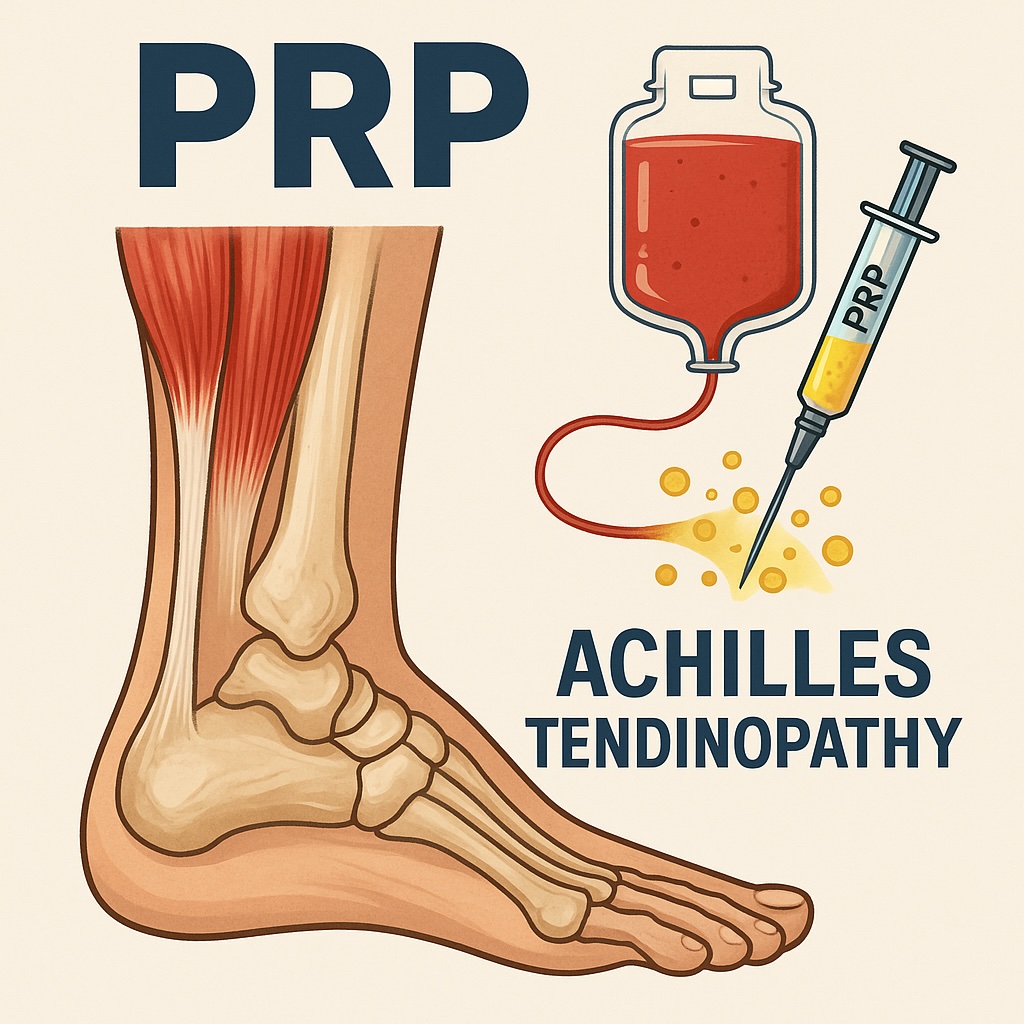Email : admin@mskdoc.co.nz | Phone : 02727 00100
Opening Hours : Mon-Friday : 10 AM – 4 PM
Email : admin@mskdoc.co.nz | Phone : 02727 00100
Opening Hours : Mon-Friday : 10 AM – 4 PM
Email : admin@mskdoc.co.nz | Phone : 02727 00100 | Opening Hours : Mon-Friday : 10 AM – 4 PM
By: Dr Zaid Matti
Musculoskeletal Medicine Specialist
Achilles tendinopathy — persistent pain and thickening in the tendon that joins your calf muscles to your heel — can sap the joy from running, jumping or even brisk walking. First‑line care still relies on progressive loading exercises, but many athletes and clinicians now ask whether platelet‑rich plasma (PRP) injections, alone or married with physiotherapy or shock‑wave therapy (ESWT), can speed the road back. Below is an evidence‑based, patient‑friendly summary.

(Straight‑talk takeaway: tendinopathy is more “wear‑and‑tear plus stalled healing” than classic inflammation, explaining why rest alone rarely cures it.)
The Alfredson protocol (heel‑drop eccentrics, 3 × 15 reps twice daily for 12 weeks) and updated heavy‑slow resistance programmes reduce pain and restore function for 60‑80 % of people, especially in mid‑portion disease.PubMed
Tip: Soreness during the exercise is normal — think of it as “working stimulus,” not fresh injury.
PRP is created by spinning a small blood sample to concentrate platelets 3–5 times above baseline. Platelets release growth factors (PDGF, IGF‑1, VEGF) that regulate collagen remodelling and small‑vessel ingrowth — both crucial for tendon repair.
(Key point: PRP is autologous, so allergy or disease‑transmission risk is minimal, but concentration and leucocyte content vary between kits and clinics.)
Evidence Snapshot | Bottom Line |
de Vos 2020 JAMA RCT (n = 54): PRP vs saline with eccentric loading. No extra pain or function benefit at 24 weeks.PubMed | PRP offered no additive valueover good rehab. |
Boesen 2017 double‑blind RCT: PRP, high‑volume saline, or sham; identical rehab. No group out‑performed sham at 6 months.PubMed | Effectiveness uncertain. |
Silva Barreto 2025 meta‑analysis (10 RCTs, 679 pts). No significant VISA‑A or pain difference overall; heterogeneity high.PubMed | Updates prior reviews – still no clear benefit. |
Vithran 2023 systematic review (14 trials). Concluded evidence inconclusive but highlighted wide variation in PRP protocols.PubMed | Standardisation needed. |
Take‑home: Current high‑quality evidence does not confirm PRP alone is superior to exercise‑only care for chronic Achilles tendinopathy.
A small pilot RCT compared a single PRP injection to a structured eccentric programme and reported similar VISA‑A improvements at 6 months.pmc.ncbi.nlm.nih.gov Today, many centres integrate PRP with supervised loading because:
Yet no large trial has proven clear additive gains, so PRP should be an adjunct, not a replacement, for physiotherapy.
Clinical pearl: ESWT can be scheduled before PRP to prime tissue circulation, or after PRP once acute soreness settles. Physiotherapists often weave it into a progressive‑loading schedule.
Step | What It Involves | Why It Matters |
1. Accurate diagnosis | Clinical exam ± ultrasound. | Rules out partial ruptures & bursitis. |
2. Baseline rehab | 12‑week eccentric / heavy‑slow plan under physio. | Proven first‑line therapy. |
3. Consider PRP if | ≥ 3 months symptoms despite adherence, or unable to increase load for sport. | PRP may “reset” stalled healing; best in mid‑portion disease. |
4. Combine wisely | Resume loading 48‑72 h after PRP; layer ESWT if plateau at 6‑week mark. | Synergy is plausible, low added risk. |
5. Lifestyle levers | Calf raises, ankle‑mobility drills, graded return to running, nutrition, sleep. | Tendon recovery is whole‑body. |
6. Realistic expectations | Improvement tends gradual (weeks–months). Multiple PRP doses rarely needed. | Prevents disappointment & over‑treatment. |
References